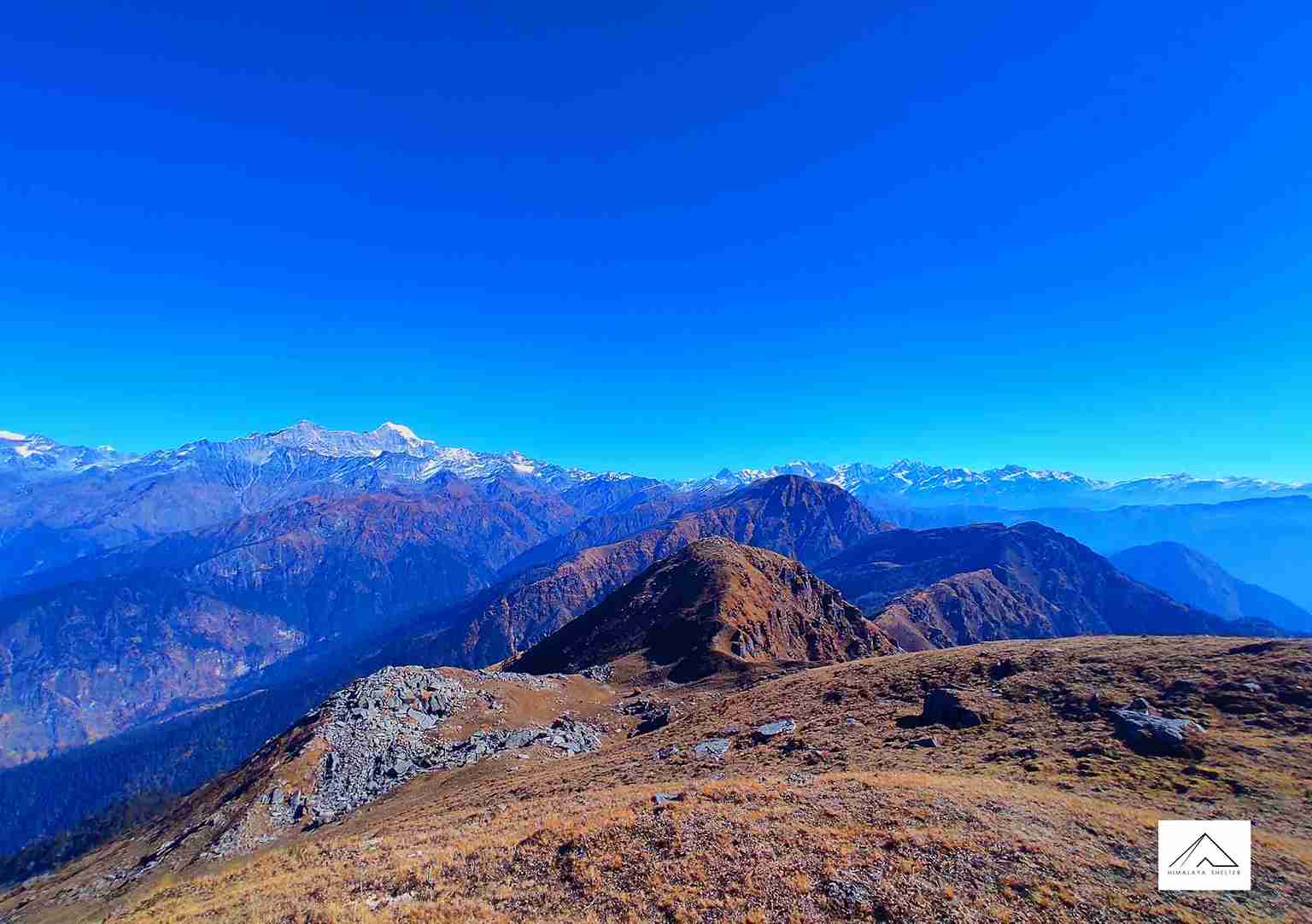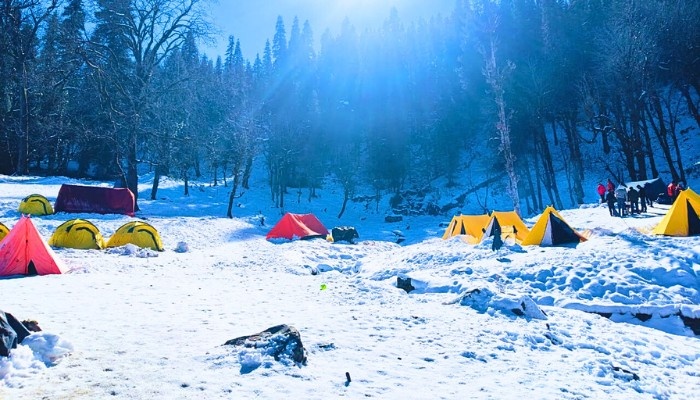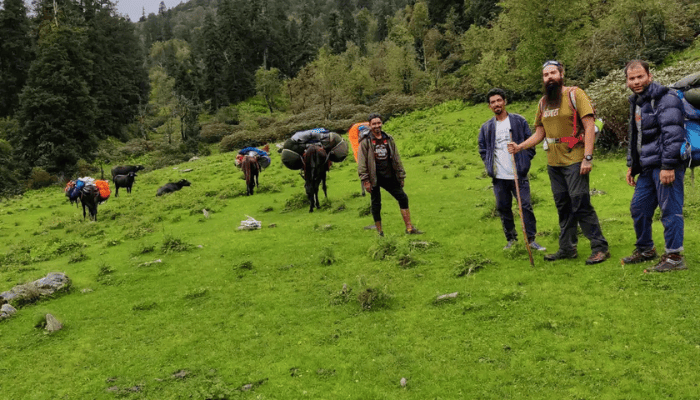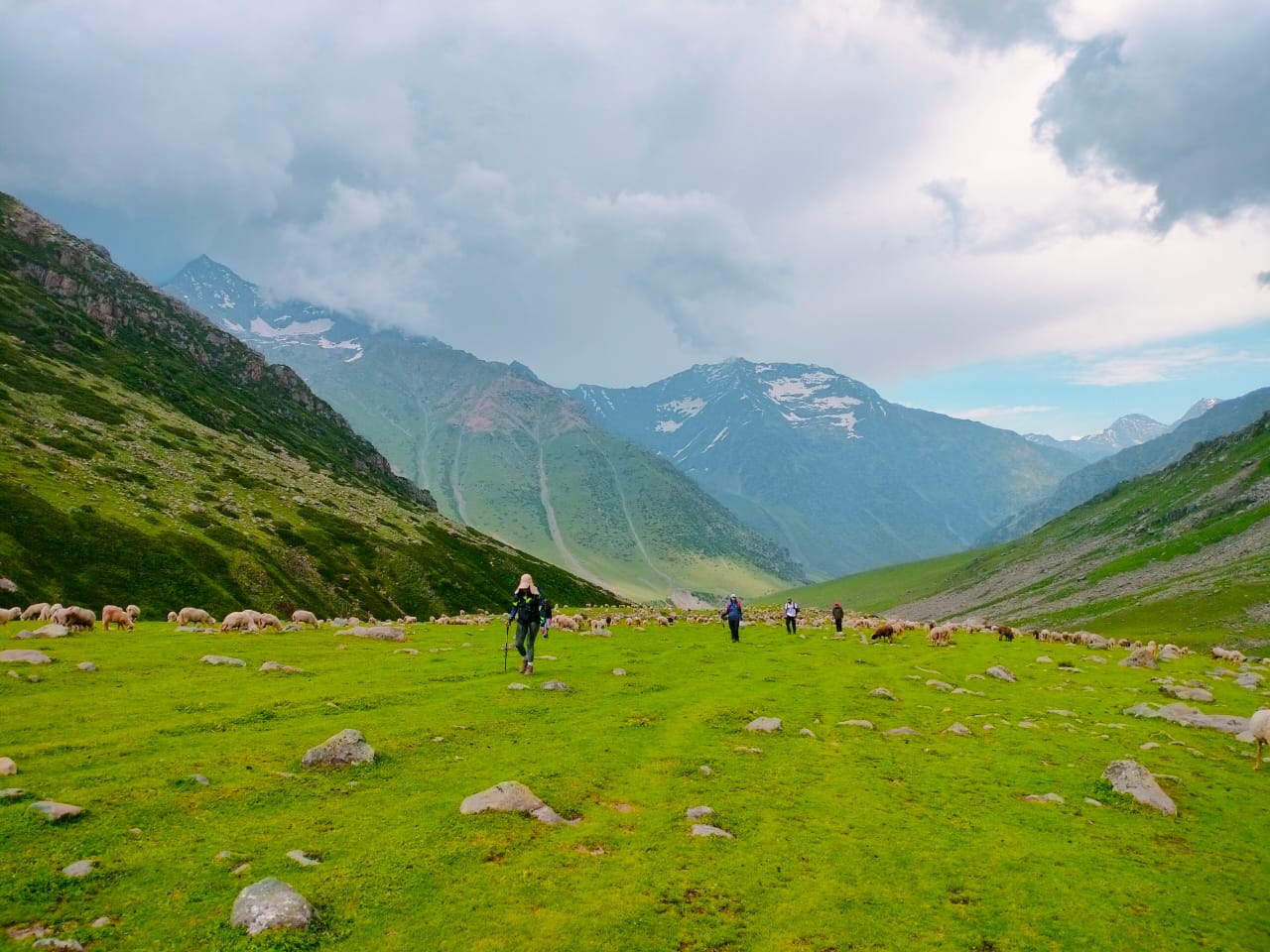
Valley of Flowers :
Welcome to the Valley of Flowers Trek, where Mother Nature went full Picasso. Valley of Flowers is situated in the Chamoli district of Uttarakhand at an altitude of 11,811 feet. The Valley of Flowers also known as ‘Foolo ki Ghati’ is unrealistically beautiful, the views from the top are therapeutic and it feels like the entire scene has been photoshopped! It is home to over 600 flower and plant species, several endangered animals, has been declared a UNESCO World Heritage site and is even considered ‘The most beautiful monsoon trek in India’.

The Valley of Flowers is home to some of very rare and uncommon species of plants and flowers. You’ll be amazed by the colours, the touch and the tendencies of these flowers. They even hold significance in ancient stories and mythology. Some of these flowers are Brahma Kamal (A sacred mythical flower that blooms late in the evening), Blue Poppy (A striking blue flower), Cobra Lily (A flower that looks peculiar with a cobra-like element sort of a hood), Bistrota Affinis (A pink/purple flower with dense spikes), Himalayan Edelweiss (A wooly flower found only on very high altitudes), and the Saxifraga Brunois (Fragile pink or white flowers. You have seen them in photos).
On the trek to Valley of Flowers, you’ll get to visit some remarkable places like Hemkund Sahib Gurudwara. It is the highest gurudwara in the world! People yearn to visit this pilgrimage site and worship as Hemkund Sahib is considered to be where Guru Gobind Sahib meditated for over 10 years. Trekkers also are rewarded with a visit to the Laxman Lokpal Temple, claimed as the highest at an altitude of 15,225 feet by the banks of the Hemkund River. This temple is believed to be where Shesha Naag (The snake God) was reborn as Laxman during Dwarapara.
Valley of Flowers on the timeline
In ancient mythology and popular belief, The Valley of Flowers was considered the abode of fairies and devtas. It’s not hard to believe considering the views though.
Besides beliefs, as facts suggest, The Valley of Flowers was discovered in 1931. Two British mountaineers were on their way back from Mt. Kamet and happened to stumble upon this route after getting lost. They were amused by the beauty (like anyone would be) and named the place – The Valley of Flowers. Then, people from around the world started visiting to study plant species and carry out other research. Much after our country gained independence, the gates to mountaineering opened and other transitions took place.
How to reach the Valley of Flowers Paradise
The Valley of Flowers treks commences from Govindghat. In order to reach Rishikesh, you can opt for road, railway or air depending on where you are coming from and your preferences. The nearest Airport to Rishikesh is Jolly Grant Airport, the nearest railway station is Haridwar Junction Railway station 25 km away and the closest bus stand is in Rishikesh itself. The distance from Rishikesh to 268 km which takes about 7-8 hours.
The best time to visit Valley of Flowers
The Valley of Flowers has a 4 to 5-month narrow window open in a year. Unlike most treks, The Valley of Flowers is at its best during Monsoon. The months from July to September are when the valley of flowers is flowering.
What does the weather look like?
Monsoon looks like rain! It might sound scary while trekking but the good news is, it rains but it does not rain too much. Expect pour every once in 2-3 days. These are not very heavy rains, you’re good to go if you are protected with the right rain shield.
The temperatures during the day are comfortable ranging between 14-18 degrees while nights can be as cold as 3-4 degrees!
Trek route, distance and duration

The journey to The Valley of Flowers starts from Govind Ghat a trek to Ghangaria which is 13 km and takes about 6-8 hours. Ghangria splits into two routes, to the Hemkund Sahib and to The Valley of Flowers. Ghangaria is the base camp of the trek. Ghangaria to Valley of Flowers is only a distance of 4 km which takes not more than 4 hours in one way. Hemkund sahib is a trek of again, 3-4 km which takes approximately 4-5 hours. The total trek length of The Valley of Flowers is approximately 38 km.
Trek difficulty and Elevation
Difficulty: The Valley of Flowers is not a difficult trek, it is a moderate trek. It can even be done by beginners, in the right fitness level and stamina.
Elevation: The trek starts at an altitude of 6,300 feet. The elevation from Govindgarh to Ghangaria is approximately 3,300 feet to an altitude of 9,600 feet. Trekkers will be touching an altitude of 11,300 feet at The Valley of Flowers. The highest altitude on The Valley of Flowers trek is 14,300 feet which is to Hemkund Sahib. The elevation is not easy, it is steady and spontaneous.
Cost and packages of Valley of Flowers
Trek Packages: The trek packages to The Valley of Flowers range between Rs. 12,000 to Rs.20,000. The charges of the package depend on the services provided, whether Hemkund Sahib is included in the itinerary and many more factors of inclusion.
Porter Services: You’ll find porters here not only to carry your luggage but to carry you! If for any reason, you can’t or don’t want to trek, you can hire these posters called ‘Sherpa’. Sherpas charge around Rs. 4000-5000 to and fro from The Valley of Flowers and around Rs.7000-8000 to and fro from Hemkund Sahib. These prices may vary according to season, sherpas and the weight of the individual who needs to be carried.
What you should know before visiting: Local laws
What you should know before visiting: Local laws
Every place has its local laws and we must abide by the same. Here are some of them that you should know before visiting:-
There is no camping allowed in The Valley of Flowers.
Entry into The Valley of Flowers is allowed only between 7 am to 12 pm.
Drone cameras are not allowed in the area.
Smoking and Drinking are prohibited.
No tolerance for Polythene
Fire Arms restricted
There are different charges for professional cameras and the use of footage for Indians and Foreigners. You’ll find a hoarding with all the details before entering the Valley of Flowers. The prices range from Rs. 500 to Rs. 1,00,000.
No littering is allowed. You may even be fined.
There’s a compulsory entry fee of approximately Rs. 150 to The Valley of Flowers.
Do’s and Don’ts
Don’ts
- Don’t be careless on slippery rocks and near Rivers. One slip can cost you your life.
- Don’t come unprepared for the steep inclinations and hours of trekking.
- Don’t forget to acclimatize properly as you are gaining altitude at a steady rate.
Do’s
- Do carry food and refreshments with you as you will get nothing of that sort in The Valley of Flowers. All you will get is fresh water from streams and rivers.
- Do keep yourself well equipped with rain gear, both for yourself and your bag pack.
- Do start exercising and running/jogging at least 30 days prior to the trek.
Now that you have read about 1000 words about The Valley of Flowers, you must be prepared to lace up those adventure boots and get on the adventure! Put VOF on your bucket list and answer the call of Foolo ki Ghati. Stay safe, happy trekking!
Must Read: Auli Uttarakhand
About Author

Himalaya Shelter
Recent news

07 Jan 2026

06 Jan 2026

03 Jan 2026
Recommended Treks

Cost: ₹11,299 | $125.46
Type: Easy
Best Time: Jan | Feb | Mar | Aprill | May | Jun | Sep | Oct | Nov | Dec


Cost: ₹9900 | $114
Type: Easy
Best Time: April to June and September to November







